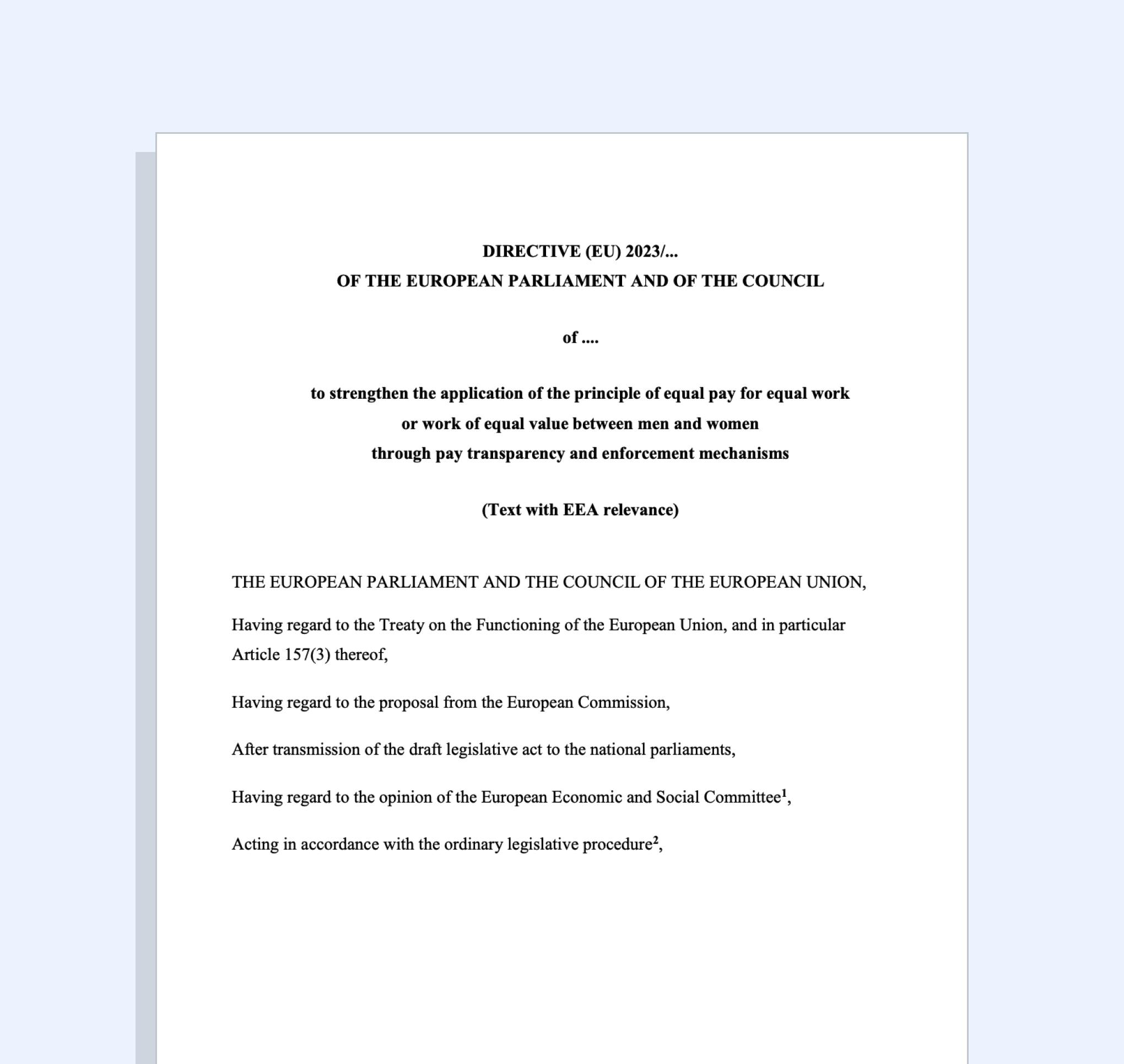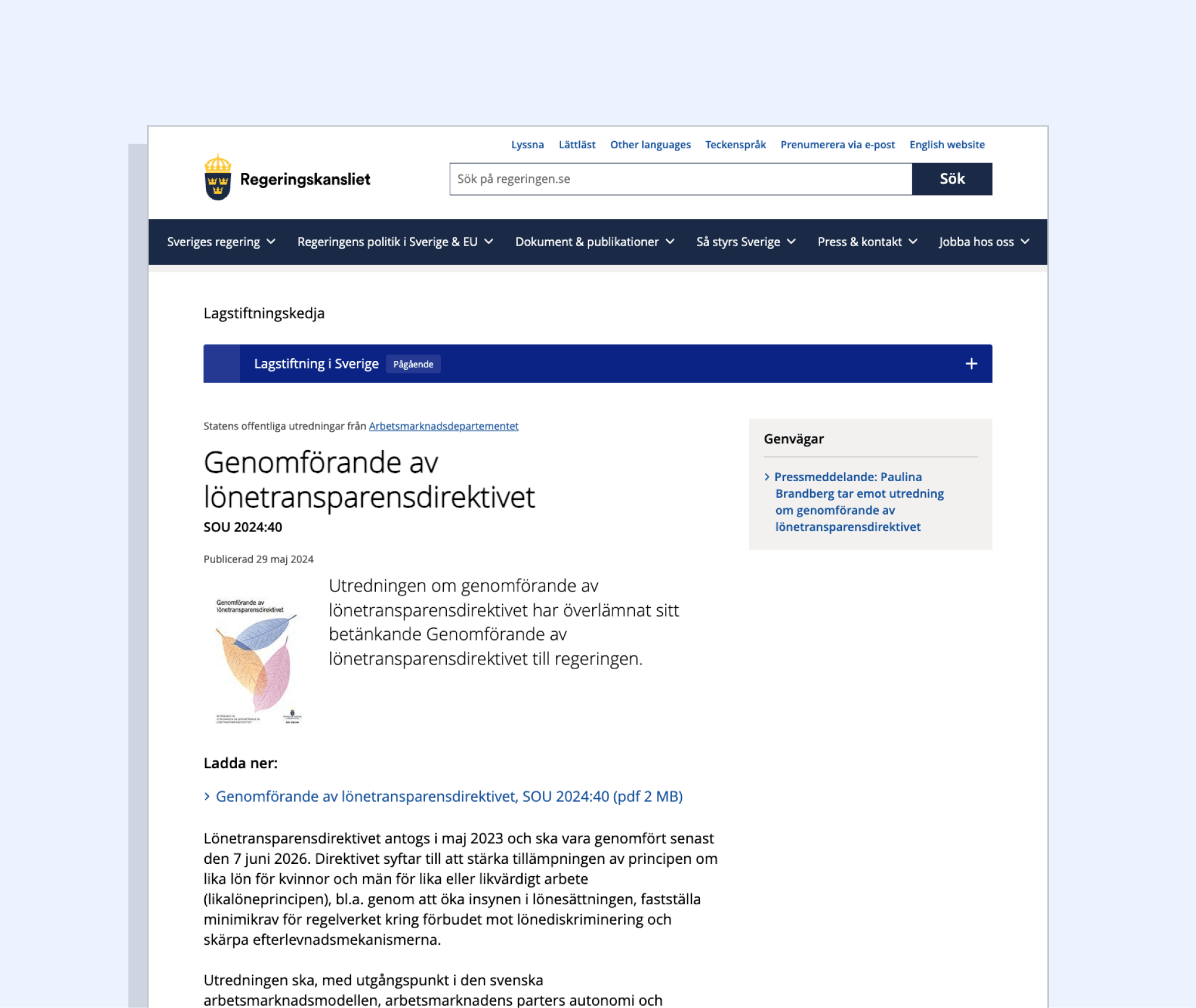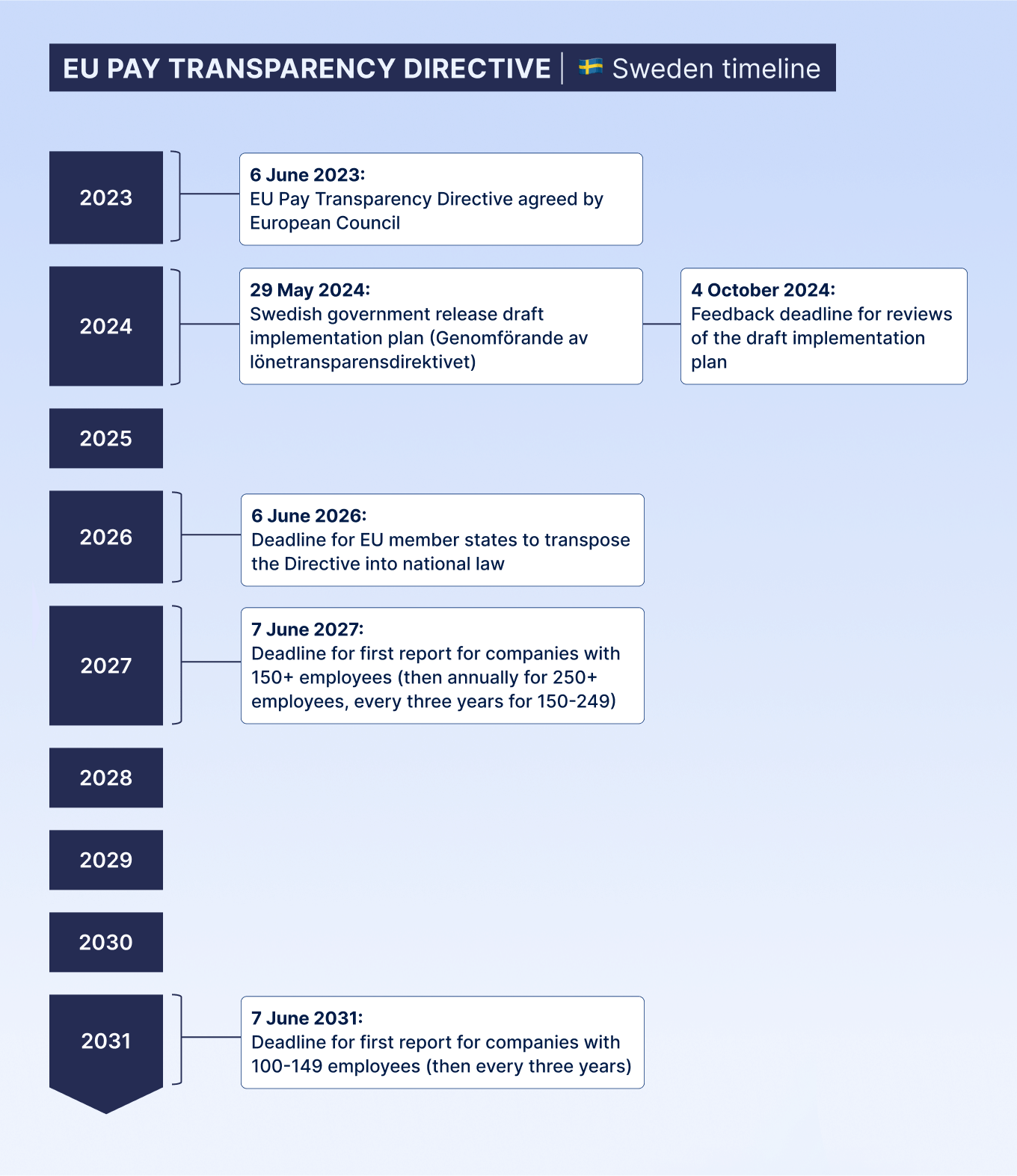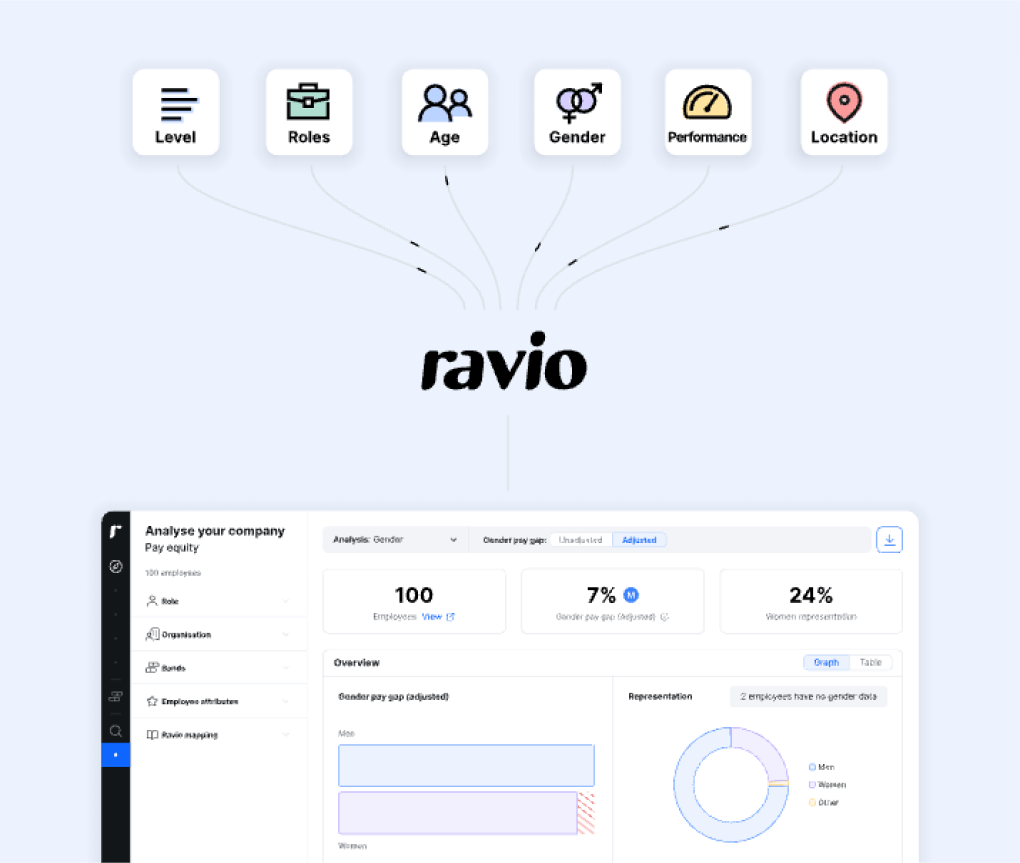Sweden has been a leading country on pay transparency for a while.
Equal pay laws are a key feature of the Discrimination Act (Diskrimineringslagen) which has been in place since 2008 – which includes the requirement for employers to submit an annual equal pay survey (lönekartläggning).
More recently, Sweden became the second member state (after Belgium) to transpose the new EU Pay Transparency Directive into national law.
The EU Pay Transparency Directive will be fully implemented by 2026, and it will mean changes for employers in terms of pay transparency requirements and equal pay reporting.
This article serves as a primer to ensure you know what’s changing and how to prepare.
Skip to the checklist ✅
Existing pay transparency laws: the Swedish Discrimination Act (Diskrimineringslagen)
The Swedish Discrimination Act (2008:567) – or Diskrimineringslagen – is a wide-ranging piece of legislation that aims to combat discrimination and promote the equal rights and opportunities of all people.
The Swedish Discrimination Act makes it illegal for workplaces, education providers (e.g. schools), and other organisations (e.g. shops or restaurants) to discriminate against people based on their gender, gender identity, ethnicity, religion or belief system, disability, sexual orientation, or age.
Compliance with the Discrimination Act is monitored by Sweden’s equality ombudsman: Diskrimineringsombudsmannen (DO).

How is pay transparency included in the Swedish Discrimination Act?
Chapter 3, Sections 4-14 of the Swedish Discrimination Act outline the ‘active measures’ that employers must take to eliminate discrimination in their company.
A large part of that focuses on hiring, pay, and progression practices, with the key elements as follows:
- Section 7: Employers must promote a balance of genders in different employee ‘categories’ (e.g. job function, job level), including in management positions. This should include learning and training provisions.
- Section 8: Employers must conduct an annual survey to analyse pay practices and identify pay differences between men and women who perform equal work or work of equal value.
- Section 9: The equal pay analysis must also include an assessment of whether existing pay differences in different groups of employees (e.g. job function, job level) are related to gender – either directly or indirectly.
- Section 13: All employers with 25+ employees must document in writing each year the active measures under sections 4-10 – including outlining all measures planned and taken in the preceding year, the outcomes of the equal pay survey and analysis, and any pay adjustments made or planned to rectify pay differences.
- Section 14: All employers with 10-24 employees must document in writing each year the process and outcomes of their equal pay survey.
Subscribe to our newsletter for monthly insights from Ravio's compensation dataset and network of Rewards experts 📩
What is required for the annual equal pay survey (lönekartläggning)?
Chapter 13, Section 8 of the Swedish Discrimination Act mandates that all employers must conduct an annual equal pay survey and analysis.
The annual equal pay survey must include the following:
- Framework for which employees perform equal work or work of equal value, which must take into account knowledge, skills, responsibility, effort, and working conditions. This effectively requires companies to have a clear job architecture and level framework to enable this assessment.
- Identification of pay differences between men and women who perform equal work or work of equal value.
- Identification of pay differences between employees who perform work that are perceived to be dominated by women (e.g. HR) and work that is not normally considered to be dominated by women (e.g. software engineering).
- Analysis of why those pay differences exist and how to rectify them
- Plans for how to rectify any identified pay differences.
Sections 13-14 mandate that all employers with 10 or more employees must document the process and outcomes of the survey.
The documentation must cover:
- How measures planned in the previous year’s report have been implemented, and their impact on rectifying pay differences.
- An outline of the process undertaken to run the equal pay survey.
- The results of the equal pay survey and analysis – the pay differences identified and analysis on why those pay differences exist and how to rectify them.
- The plan to rectify any identified pay differences e.g. planned pay adjustments, including expected costs and a timeline – with the expectation that actions should be taken as soon as possible, and within three years at the most.
The upcoming 2026 EU Pay Transparency Directive (Lönetransparensdirektivet)
The EU Pay Transparency Directive is a new piece of legislation set by the European Council.
Its purpose is to close Europe’s gender pay gap by increasing pay transparency amongst EU companies (and companies with employees based in the EU). The Directive applies to all companies who are based in the EU themselves or have employees located in the EU.
The EU Pay Transparency Directive was officially agreed by the European Council in June 2023 – the Directive being a set of rules that EU member states now have until 7 June 2026 to transpose into their national laws.
This means there will be new Swedish laws in place by June 2026 that supersede the existing pay transparency laws those in the Discrimination Act.

How does the EU Pay Transparency Directive differ from the Discrimination Act?
The EU Pay Transparency Directive introduces stricter pay transparency and gender pay gap reporting requirements for employers than the existing Swedish Discrimination Act.
The key changes introduced by the EU Pay Transparency Directive are as follows:
- Employee understanding of pay and career progression. Employers must make ‘easily accessible’ to employees the criteria used for determining pay for each job level, and career progression between levels. The criteria used must be gender neutral.
- Employee rights to pay information. Employees are entitled to information about the pay of colleagues who perform equal work or work of equal value to them. Employers must make employees aware of this right at least once per year.
- Job applicant rights to pay information. Employers are required to disclose the salary range for all new roles to candidates before interviews.
- Salary history ban. Employers are banned from asking candidates about their salary history during the hiring process.
- The burden of proof shifts to the employer. In any case of complaint the employer will need to prove that pay discrimination has not taken place in the case of complaint – historically the employee would have to prove that pay discrimination has taken place.
- New gender pay gap reporting requirements. All employers with 100+ employees are required to submit detailed gender pay gap reports (see more details below). Any company with an unjustifiable gender pay gap of over 5% for any ‘category’ of employees must rectify it within 6 months, or conduct a further joint pay assessment.
Points 1-5 are completely new for Sweden and do not appear within the existing Swedish Discrimination Act (Diskrimineringslagen).
Gender pay gap reporting (point 6) is included in the existing Discrimination Act – but this will change with the EU Pay Transparency Directive.
Gender pay gap reporting: EU Pay Transparency Directive vs Discrimination Act
In terms of eligibility, the EU Pay Transparency Directive is actually more lenient than the Swedish Discrimination Act. The EU Pay Transparency Directive requires employers with 100+ employees to submit gender pay gap reporting, whereas the Swedish Discrimination Act requires all employers with 10+ employees to document the process and outcomes of an equal pay survey and analysis.
However, the Swedish Discrimination Act enables companies to decide themselves how they will calculate, document, and rectify pay differences between men and women.
In comparison, the EU Pay Transparency introduces a strict format for gender pay gap reporting, with employers required to calculate and include the following:
- Gender pay gap (mean and median)
- Gender pay gap for variable pay (mean and median)
- The proportion of men and women who receive variable pay
- The proportion of men and women in each pay quartile (lower, lower middle, upper middle, upper)
- The gender pay gap for each ‘category’ of workers – where a ‘category’ refers to a group of employees that perform equal work or work of equal value (which must be grouped in a structured way that is ‘non-arbitrary’, ‘non-discriminatory’, and ‘objective’).
- The gender pay gap for variable pay for each ‘category’ of workers.
The final two points i.e. the gender pay gap for base salary and variable pay amongst each ‘category’ of employees, must be communicated to all employees too.
Employers with 250+ employees must submit their gender pay gap reporting every year from 2027 onwards. Employers with 100+ employees must submit once every three years, starting from 2027 for those with 150-249 employees, and 2031 for those with 100-149 employees.
Employers who have a gender pay gap above 5% in any of the above categories must be able to justify the pay gap through objective and gender neutral reasoning, or rectify it within 6 months of filing the report.
If this cannot be achieved, they must conduct a ‘joint pay assessment’ – a further analysis in collaboration with employee representatives, to identify the root causes of pay inequity and put measures in place to address those causes.
Sweden’s implementation of the EU Pay Transparency Directive (Genomförande av lönetransparensdirektivet)
On 29 May 2024 the Swedish government released a report (Genomförande av lönetransparensdirektivet) on their initial plans and recommendations for the implementation of the EU Pay Transparency Directive into Swedish law.
The full report in Swedish is available via the government website.

The response to the implementation plans has largely focused on the fact that Sweden seems to intend to go above and beyond the requirements of the EU Pay Transparency Directive (see the section above ‘How does the EU Pay Transparency Directive differ from the Discrimination Act?’ for a reminder on the key changes required by the Directive).
Sweden has a strong history as a leader in equality, including gender equality policies, so this is unsurprising. As one of the first EU member states to state their initial plans for implementation, this could well set the stage for other countries to follow suit.
Here’s a summary of how Sweden’s plans surpass the Directive’s requirements.
In terms of pay transparency rules, there are a couple of important additions:
- Collective agreements disclosure to job applicants. Employers must provide job candidates with applicable collective agreement provisions as well as the salary range for the role – collective agreements are a core feature of Sweden’s labour law, so it makes sense that this is added. This information does not have to be given prior to interview but must be given before salary negotiations begin – whereas the Directive’s wording suggests that it should be prior to interview (‘in a published job vacancy notice, prior to the job interview or otherwise’).
- Employee right to request pay information through employee representatives. Employees can request pay information through employee representatives or gender equality bodies instead of directly to the employer – all companies with 25+ employees in Sweden have employee representatives on their board of directors so, again, this makes sense as an addition.
But the biggest differences are in the gender pay gap reporting requirements:
- The current equal pay survey for employers with 10+ employees remains. Whilst the new gender pay gap reporting requirements are only applicable for employers with 100+ employees (as per the Directive), Sweden will maintain current pay equity reporting requirements under the Swedish Discrimination Act for employers with 10+ employees.
- Transparent communication of job evaluation approach. Companies must present to employees how each ‘category’ of employees (i.e. groups of employees conducting equal work or work of equal value) has been determined – including the factors and reasoning behind the value given to each job role and job level. This is implied in the Directive due to the emphasis on pay transparency, but Sweden seems to plan to make this explicit.
- Analysis of the impact of parental leave on pay progression. Gender pay gap reporting must include a comparison of pay progression for men and women who take parental leave, compared to their peers who do work of equal value but do not take parental leave. This is a completely new addition, but is absolutely an important factor to analyse due to the clear impact of childbearing and childcare on career progression for women.
- Public reporting. Employers with a pay gap of more than 5% in any reported category must submit their report to Sweden’s equality body (the Diskrimineringsombudsmannen or DO) who will collect and publicly present aggregated data.
- Non compliance fines. Employers who fail to submit their report to the DO will be fined for non-compliance, with a maximum penalty of 50,000 euros.
💡 Will systems be provided to support employers with pay equity analysis?
Sweden’s initial response to the EU Pay Transparency Directive specifically states that the DO will not provide a state-funded system or tool to support with the required pay equity analysis and reporting, but will leave it to the market to offer suitable tools.
This means that all employers will need to look into pay equity software options (like Ravio’s) to support accurate and compliant calculations – unless they have the in-house expertise and resources to manage this internally.
What are the next steps for the EU Pay Transparency Directive (lönetransparensdirektivet) in Sweden?
From May until October 2024 Sweden’s proposal for implementing the EU Pay Transparency Directive (Genomförande av lönetransparensdirektivet) was reviewed by relevant organisations and bodies – with a feedback deadline of 4 October 2024.
The government will now take that feedback into consideration to produce a draft legislative proposal, which will then be voted on by the Swedish parliament.
There may be further rounds of review and revisions from there.
The final deadline for implementing the EU Pay Transparency Directive into Swedish law is 7 June 2026 – so it will be in place before then.
The new gender pay gap reporting will then begin in 2027 (on 2026 data) for employers with 250+ employees.

What do Swedish companies need to do to prepare for the EU Pay Transparency Directive (lönetransparensdirektivet)?
The enforcement of the EU Pay Transparency Directive will mean significant changes for many employers in Sweden, so it’s well worth starting to get plans in place now.
For increased transparency for job applicants, employers will need to ensure their hiring practices and processes are compliant:
- Ensure gender neutral language is used in all job adverts, job descriptions, and any other hiring documentation.
- Update the hiring process to include the requirement to include sharing the salary range and applicable collective agreements with all candidates – which must be before any salary conversations or negotiations begin.
- Ensure interview guidelines include the requirement to never ask candidates about their salary history.
- Remove pay secrecy clauses from any employment contract templates – this may also mean creating new contracts for existing employees.
The new requirements for pay transparency for existing employees mean that many companies will need to revisit their compensation approach to ensure it is robust:
- Ensure that there is ‘easily accessible’ documentation for employees on the objective, gender neutral criteria used to determine salaries for each job level in the company, as well as career progression between those levels. This effectively means educating employees on the company’s compensation philosophy (including the approach to benchmarking and salary bands), job architecture, level framework, and career progression framework – and the requirement to ensure this is ‘objective’ may mean revisiting and improving those frameworks to ensure a well-defined approach is taken. Some are interpreting this to mean that companies must use the point factor evaluation approach, but this is not a requirement.
- Introduce a process for annually informing employees of their right to request salary information for peers who perform work of equal value to them.
- Introduce a process for sharing that salary information with employees who do request it.
In terms of the new gender pay gap reporting requirements, there is no change for employers with 10-99 employees.
Employers with 100+ employees will need to prepare their first gender pay gap calculations (2027 for employers with 250+ employees, 2031 for those with 100-249), which means:
- Defining the ‘categories’ of employees who perform equal work or work of equal value within the company – this will require a well-defined, objective level framework (which is also needed for the pay transparency requirements for employees, so is a particularly important step).
- Gathering compensation data: base salary and variable pay for all employees, the proportion of men and women who receive variable pay, the proportion of men and women in each pay quartile, salary increase data for employees who have taken parental leave vs those that haven’t.
- Performing gender pay gap calculations: gender pay gap for base salary and variable pay (mean and median), gender pay gap for base salary and variable pay for each ‘category’ of employees, pay progression for employees who have taken parental leave vs those that haven’t.
- Conducting further analysis of any areas which have a gender pay gap of over 5% to understand the root causes and put plans in place to rectify this.
- Producing the final gender pay gap report for submission to the DO (if there is a pay gap of over 5% in any area).
- Introducing a process for communicating the outcomes of the gender pay gap reporting to employees.
🇸🇪 Free checklist: prepare for the EU Pay Transparency Directive
We’ve put together a checklist to make it easy to understand which steps your company needs to take to prepare for the EU Pay Transparency Directive to be in place in Sweden.
It can also be used as a workbook to make notes and track progress as you implement any required changes.
How Ravio can support the implementation of pay transparency and gender pay gap reporting
Gathering the right data and running the required gender pay gap calculations for EU Pay Transparency Directive reporting will be a lengthy and time-consuming process.
If done manually, there’s also a high risk of human error causing inaccuracies which could impact the outcomes.
Pay equity tools like Ravio’s can help to speed up the process and ensure accuracy.
Ravio connects directly with your HRIS system, needing minimal setup time to gather the data needed on pay for men and women within your organisation.

Once connected, pay equity insights are immediately available in your Ravio account.
This includes gender pay gap calculations – both overall, and for specific groups of employees e.g. gender pay gap per job level, gender pay gap per job family, gender pay gap per employee location, and more – making it easy to get ahead of the gender pay gap calculations required by the EU Pay Transparency Directive.
Pay equity metrics are currently available only for base salary, with total compensation (including variable pay required for the EU Pay Transparency Directive) coming in 2025. To be notified when this is available, please contact our team who will keep you updated.

Plus, if you need to ensure a more structured and well-defined approach to compensation, Ravio can help with this too.
In terms of job architecture and levelling, every company that joins the platform is mapped against the best practice Ravio level framework – either matching your internal levels to Ravio’s levels if you already have a level framework in place, or mapping your individual employees to Ravio’s levels if you don’t. This is a vital foundation for the pay transparency and employee communication requirements within the EU Pay Transparency Directive.

It’s then a simple task to compare employees’ existing salaries with current market data and create (or edit existing) salary bands to fit the approach you want to implement. Benchmarks and bands can also be shared outside of Ravio to support employee communication and understanding requirements.

What is Sweden’s current gender pay gap?
Sweden is seen as a leader in gender equality in Europe, but there is still a significant gender pay gap – as we can see in the findings of Ravio’s 2024 Pay Equity Report.

Overall, Sweden has an unadjusted gender pay gap of 16% and an adjusted gender pay gap of 3.4%.
The unadjusted gender pay gap is the raw figure, the overall average difference in pay between men and women (given as either mean or median). The adjusted gender pay gap takes into account any ‘justifiable’ factors for that difference e.g. seniority, level of experience.
It’s the adjusted gender pay gap which is the most important in the context of the EU Pay Transparency Directive. The requirement to calculate the gender pay gap for every ‘category’ of employees that perform equal work or work of equal value is the adjusted gender pay gap calculation – and it’s this that will require a joint pay assessment if there is a gender pay gap of over 5% in any ‘category’.
As we can see, the average adjusted gender pay gap in Sweden falls below that 5% requirement, at 3.4%. This puts Swedish companies in a much better position than other European countries like the Netherlands or Spain. However, this is, of course, an overall median figure – some companies will sit below this, and some above.
It’s also interesting to note the percentage of female leaders in Sweden. Just 15% of all female employees in Sweden occupy leadership positions (P4-P6, M3-M5), which is one of the lowest figures in Europe – so this could be an important area for Swedish companies to focus on in their pay equity work.



